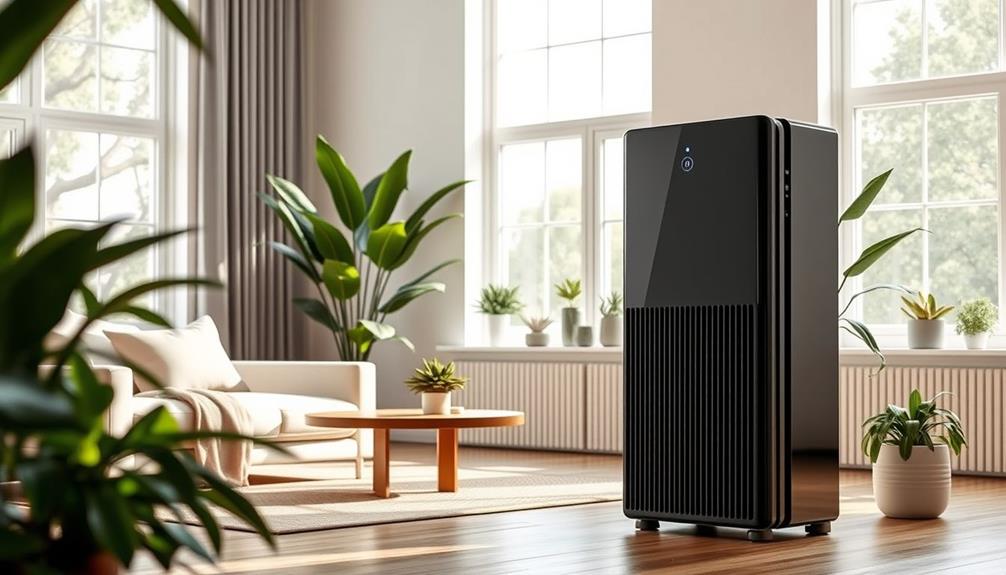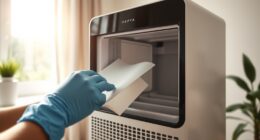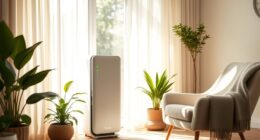I’ve always been curious about what is contained within those big air purifiers, how they function, and whether I have the ability to clean them on my own.
Well, the wait is over! In this article, I’ll guide you step-by-step on how to open a large air purifier and give it the TLC it deserves.
We’ll cover everything from the tools you’ll need to the safety precautions you should take.
So, get ready to unveil the secrets hidden within your air purifier and breathe cleaner air once again.
Key Takeaways
- Follow the manufacturer’s instructions for safe handling and assembly of the air purifier.
- Locate and open the access panel by removing screws or releasing clips, ensuring the device is unplugged.
- Use the appropriate screwdriver size and type, wear gloves and safety goggles, and apply steady pressure when removing screws to prevent slippage and minimize the risk of injury.
- When reassembling the air purifier, properly replace filters, clean them regularly, and follow the manufacturer’s instructions for optimal performance.
Tools Needed
You’ll need a screwdriver to open the large air purifier.
The first step in accessing the internals of the air purifier is to locate the screws that secure the outer casing. These screws are typically found on the back or bottom of the purifier.
The size of the screwdriver required will depend on the specific model of the air purifier. Check the user manual or look for markings near the screws indicating the screwdriver size.
Once you have the correct screwdriver, insert it into the screw heads and turn counterclockwise to loosen and remove the screws. It is important to keep track of the screws as you remove them to ensure easy reassembly later on.
With the screws removed, you can now carefully lift off the outer casing to access the internal components of the air purifier.
Safety Precautions
Before starting, it’s important to take safety precautions when handling the device. Opening a large air purifier requires careful disassembly to ensure safety and efficiency.
First, unplug the device from the power source to avoid any electric shock. Next, wear protective gloves and goggles to shield yourself from potential hazards. It is also advisable to work in a well-ventilated area to prevent inhalation of any dust or particles.
When disassembling the air purifier, follow the manufacturer’s instructions carefully to avoid damaging any components. During the process, be cautious of sharp edges and delicate parts.
Regular maintenance of the air purifier is essential for optimal performance. Clean or replace filters as recommended by the manufacturer and ensure proper reassembly of the device to avoid any malfunction.
Unboxing the Air Purifier
When unboxing the device, make sure to follow the manufacturer’s instructions for safe handling and assembly. The disassembling process of a large air purifier can be quite intricate, but with proper guidance, it can be done efficiently.
Here are some maintenance tips to keep in mind during the disassembling process:
-
Clean the Filters: Remove the filters from the air purifier and gently clean them using a soft brush or vacuum cleaner. This will help maintain the purifier’s efficiency.
-
Check for Dust Buildup: Inspect the internal components for any dust buildup. Use a microfiber cloth or compressed air to remove the dust from the fan blades, vents, and other areas.
-
Inspect the Motor and Electrical Connections: Carefully examine the motor and electrical connections for any signs of damage or loose connections. If any issues are found, consult the manufacturer’s instructions for proper troubleshooting steps.
Locating the Access Panel
When it comes to accessing the inner components of an air purifier, locating the access panel is crucial. The access panel is typically located on the back or side of the air purifier, depending on the model.
To ensure easy access, manufacturers often design the access panel with user-friendly features such as quick-release latches or easily removable screws.
Access Panel Location
The access panel’s location can typically be found at the back of the air purifier. It serves as the gateway to the internal components of the device, allowing for air purifier maintenance and troubleshooting common issues.
To access the panel, first, ensure that the air purifier is unplugged from the power source. Next, locate the screws or clips that secure the panel in place. Using a screwdriver or your fingers, remove the screws or release the clips.
Carefully slide or lift off the access panel, being mindful not to damage any wires or delicate parts. Once the panel is removed, you will have complete visibility and access to the filters, fan, and other vital components for maintenance or troubleshooting purposes.
Easy Access Methods?
To easily access the panel, you can use a screwdriver or your fingers to remove the screws or release the clips. Once the panel is removed, you will have direct access to the inner components of the air purifier.
However, there are alternate methods that can be used to open the panel without the need for tools. Here are three options to consider:
-
Using a credit card: Gently insert a credit card into the gap between the panel and the main body of the air purifier. Apply slight pressure and move the card along the edges to release the clips and remove the panel.
-
Using a suction cup: Place a suction cup on the panel and pull it away from the air purifier. This method creates enough force to disengage the clips and open the panel.
-
Using a hairdryer: Apply heat to the edges of the panel using a hairdryer. The heat will soften the adhesive holding the panel in place, making it easier to remove without damaging it.
Removing the Screws
Before beginning the process of removing the screws from the access panel of the air purifier, it’s important to consider the appropriate screwdriver size and type. Using the wrong size or type of screwdriver can lead to stripped screws or damage to the device.
Additionally, it’s crucial to follow safety precautions while unscrewing. This includes wearing protective eyewear and gloves to prevent any potential injuries.
Screwdriver Size and Type
You’ll need a Phillips head screwdriver to remove the screws on the air purifier. When it comes to screwdriver types, there are a few options to consider. Here are some key points to keep in mind:
-
Phillips head screwdriver: This type of screwdriver has a cross-shaped tip and is commonly used for removing screws with Phillips head slots.
-
Flathead screwdriver: This screwdriver has a flat, slotted tip and is suitable for screws with a single slot.
-
Torx screwdriver: This type of screwdriver has a star-shaped tip and is often used for specialized screws found in electronics and appliances.
Remember to choose the right screwdriver size as well. The size is usually indicated by a number or letter, such as #1 or T10, which corresponds to the size of the screw head.
Now that you know about screwdriver types and sizes, let’s move on to the next section about safety precautions while unscrewing.
Safety Precautions While Unscrewing
Now that we have determined the appropriate screwdriver size and type for opening the large air purifier, let’s move on to discussing the safety precautions that should be taken while unscrewing the device.
Safe handling is of utmost importance to prevent any accidents or injuries during the process.
Before starting, it is crucial to wear the necessary protective gear, such as gloves and safety goggles, to protect oneself from potential hazards. These precautions help minimize the risk of cuts, scratches, or exposure to harmful particles that may be present inside the air purifier.
When unscrewing the device, it is essential to apply steady pressure to the screwdriver, ensuring a firm grip to prevent slippage. Additionally, it is recommended to work in a well-ventilated area to avoid inhaling any dust or particles that may be released during the opening process.
Opening the Cover
To open the cover, just grab the handle and gently pull it towards you. The large air purifier is designed for easy removal of the cover, ensuring hassle-free maintenance.
Here are three alternative methods you can try if the handle doesn’t work:
-
Use a flathead screwdriver to pry open the cover gently, starting from one corner and working your way around. Be cautious not to apply too much force to avoid damaging the unit.
-
Look for any release buttons or levers on the sides of the air purifier. Press or slide them to unlock the cover and then lift it off.
-
Refer to the user manual for specific instructions on how to open the cover. It may provide additional information or troubleshooting steps if you encounter any difficulties.
Remember to always exercise caution and follow the manufacturer’s guidelines to ensure the safe and proper removal of the cover.
Removing the Filters
When it comes to maintaining an air purifier, three key points to consider are filter replacement frequency, cleaning the filters, and the importance of proper installation.
Filter replacement frequency is crucial as it ensures the air purifier continues to effectively remove pollutants from the air.
Cleaning the filters is also essential to maintain their efficiency and prolong their lifespan.
Lastly, proper installation is important to ensure optimal performance and prevent any air leaks that could compromise the air purifier’s effectiveness.
Filter Replacement Frequency
You should check the filter replacement frequency of your large air purifier regularly to ensure optimal performance. Regularly replacing the filters in your air purifier offers several benefits, including improved air quality and increased lifespan of the device.
Here are some key points to consider about the filter replacement frequency:
- Regular filter replacement helps maintain the effectiveness of the air purifier in removing pollutants such as dust, pollen, and pet dander.
- Neglecting to replace filters can lead to decreased airflow and reduced filtration efficiency, compromising the purifier’s ability to clean the air.
- The cost of filter replacement varies depending on the type and brand of the air purifier, but it is a necessary investment for maintaining clean and healthy indoor air.
By following the recommended frequency for filter replacement, you can ensure that your large air purifier continues to function optimally and provide you with cleaner air.
Now, let’s move on to the next section about cleaning the filters.
Cleaning the Filters
Cleaning your filters regularly is essential for maintaining the effectiveness and efficiency of your air purifier. Regular cleaning helps to remove trapped particles and ensures that your air purifier continues to provide clean air. The cleaning frequency will depend on the specific model and usage, but as a general guideline, it is recommended to clean the filters every 2 to 3 months.
To clean the filters, first, turn off the air purifier and unplug it from the power source. Remove the filters according to the manufacturer’s instructions. Use a vacuum cleaner or a soft brush to gently remove dust and debris from the filters. If the filters are washable, rinse them with water and let them air dry completely before reinstalling.
Regular cleaning of filters is a simple maintenance tip that can greatly prolong the lifespan of your air purifier and ensure its optimal performance.
In addition to regular cleaning, proper installation of your air purifier is crucial to maximize its effectiveness.
Importance of Proper Installation
For optimal effectiveness, it’s important to properly install your air purifier in the designated area. This ensures that the air purifier can effectively clean the air in your space and provide you with clean and healthy air to breathe.
Here are some important steps to follow for proper installation:
-
Choose the right location: Find a central location in the room where the air purifier can circulate the air efficiently.
-
Check the airflow: Make sure there are no obstructions around the air purifier that can hinder its performance.
-
Plug it in: Connect the air purifier to a power source and ensure that it is securely plugged in.
Proper installation of your air purifier not only ensures its optimal performance but also makes it easier for you to perform filter maintenance. By following these steps, you can enjoy the many benefits of air purification, such as improved indoor air quality and reduced allergies and respiratory issues.
Cleaning the Filters
To properly maintain the air purifier, it’s essential to regularly clean the filters. Cleaning the filters is a crucial step in ensuring the optimal performance of your air purifier.
There are various cleaning techniques that can be employed to effectively remove the accumulated dirt and debris from the filters. One method is to gently vacuum the filters using a soft brush attachment to remove loose particles.
Another technique is to rinse the filters under running water, ensuring that the water pressure is not too high to avoid damaging the filter material. It is important to follow the manufacturer’s instructions for cleaning and maintenance, as each air purifier may have specific requirements.
Establishing a regular maintenance schedule for cleaning the filters will help to prolong the lifespan of your air purifier and maintain its efficiency in purifying the air.
Reassembling the Air Purifier
After cleaning the filters, it’s time to reassemble the air purifier by carefully following the manufacturer’s instructions. Reassembling the air purifier is an important step to ensure its proper functioning.
Here are some easy reassembly tips that can help you with this task:
-
Organize the parts: Lay out all the components in a clear and organized manner to avoid confusion during reassembly.
-
Follow the manual: Read the manufacturer’s instructions thoroughly to understand the correct sequence and alignment of the parts.
-
Take your time: Rushing through the reassembly process may lead to mistakes. Take your time and be patient to ensure everything is put back together correctly.
Powering On the Air Purifier
Once the filters have been reassembled, it’s time to power on the air purifier and enjoy cleaner indoor air.
Before we begin, it is essential to understand the different powering methods available for air purifiers. Most models can be powered using a standard electrical outlet, while some may also offer the option of battery power or USB connection.
When using an electrical outlet, ensure that the power cord is securely plugged in and that the outlet is functioning correctly. If the air purifier fails to turn on, check the power source and try a different outlet if necessary.
If the issue persists, refer to the troubleshooting tips provided in the user manual or contact the manufacturer for further assistance. Remember, a properly powered air purifier is crucial for maintaining optimal indoor air quality.
Troubleshooting Tips
If your device fails to turn on, make sure to check the power source and try a different outlet if necessary. Troubleshooting issues with an air purifier can be frustrating, but with some simple steps, common mistakes can be easily resolved. Here are some tips to help you troubleshoot your air purifier:
-
Check the power cord: Ensure that the power cord is securely plugged into both the air purifier and the electrical outlet. A loose connection can prevent the device from turning on.
-
Clean or replace the filters: Dirty or clogged filters can hinder the airflow and reduce the efficiency of the air purifier. Regularly clean or replace the filters as per the manufacturer’s instructions.
-
Reset the device: Some air purifiers have a reset button or a power cycle feature. Try resetting the device to see if it resolves any technical issues.
Conclusion
In conclusion, opening a large air purifier is a straightforward process that requires a few simple steps. By following the safety precautions and using the necessary tools, you can easily access the filters and clean them for optimal performance.
Imagine the satisfaction of removing the screws and unveiling the inner workings of the purifier, revealing a world of clean air possibilities.
So, go ahead and embark on this technical adventure, knowing that a breath of fresh air awaits you on the other side.










